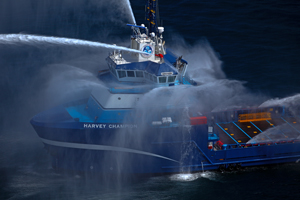Building on the achievements of its first Tiger Shark-class platform supply vessels, Eastern Shipbuilding Group has launched a new series of three boats featuring diesel-electric propulsion, enhanced berthing and unprecedented environmental credentials.
The first delivery from its Panama City, Fla., shipyard was Harvey Supporter, for Harvey Gulf International Marine. The 292-foot PSV is at work in the Gulf of Mexico, setting a new standard for stationkeeping, cargo transfer and eco-friendliness.
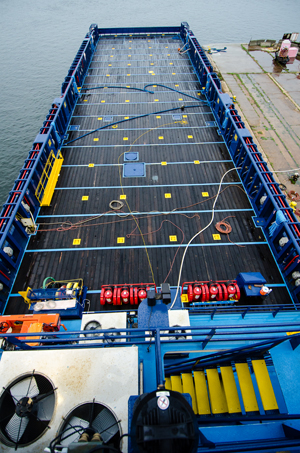 |
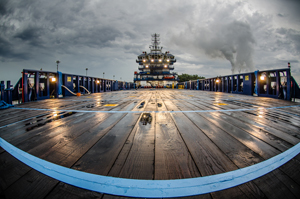 |
|
Brian Gauvin The power plant is located on the main deck forward, clearing space below. With a 196-foot-long cargo deck, Harvey Champion can carry 3,125 long tons on deck. |
“It’s pretty much everything you can have for an offshore supply vessel,” said Kenneth Munroe, Eastern Shipbuilding’s executive vice president and chief operating officer.
The third vessel, Harvey Champion, is a sister vessel to Supporter. Both PSVs boast four Cummins 1,825-kW Tier II main engines in concert with four Hyundai generators — plus one emergency generator — in a highly redundant diesel-electric system. As with the Tiger Shark-class vessels, the power plant is located on the main deck forward.
“That’s one of the big selling points, is getting away from having the machinery below deck,” said Michael Carroll, vice president of operations with STX US Marine, the designer. “It’s definitely a significant plus. It allows for an increase in cargo capacity (over) a similar-size vessel.”
The redundant power system allows the operator to optimize fuel use and handle a difficult sea state. And it enables the vessel to continue sailing even if a fire or collision disables one compartment.
“Our customer base says we want to carry as much as we can for as cheap as we can. These diesel-electric vessels give you the ability to cut fuel consumption,” said Chad Verret, Harvey Gulf’s senior vice president for deepwater operations. “It allows you to decide how much power you want to dedicate to propulsion. You can maximize fuel consumption, or if you need more speed you can put another generator on line.”
 |
The new series is an enhanced version of the PSVs that Eastern built in 2010-11 for Aries Marine — the 292-foot Betty Pfankuch and Dwight S. Ramsay (our Ship of the Year for 2012). At the time, the two Aries boats were the largest-capacity PSVs in the Americas.
Champion can carry 19,500 barrels of liquid mud and 1,700 barrels of methanol, and the cargo deck is 196 feet long. The vessel has 47 to 50 sleeping berths, versus 32 on the Aries boats. The Harvey Gulf PSV’s maximum speed is 14 knots.
Harvey Supporter operates on long-term charter to Hess Oil Corp. The second vessel in the series, Harvey Gulf’s Sisuaq, with doubled bow plating, ice detectors and additional heating elements, has been hired by Shell for offshore exploration in Alaska’s Beaufort Sea. Harvey Champion was launched in February, underwent sea trials over the summer and was delivered in August.
Eastern and STX used a systems-integrator model to equip the Tiger Shark-class boats for maximum crew control over propulsion efficiency and navigational flexibility. That integrator, General Electric Co.’s Converteam division, subcontracted systems including switchboards and marine electronics.
“We worked with Harvey Gulf to enhance the Tiger and make it beefier, with more quarters,” Munroe said. “We bought z-drives and bow thrusters, and we bought the engines from the engine manufacturer, and then we had the integrator integrate everything else. … It worked, so we built on that.”
The robust and agile propulsion components support top-notch dynamic positioning (DP) abilities. The boats, featuring the Converteam Duplex C series, are rated DPS-2.
“We wanted to have the best DP boat out there,” Munroe said. “It’s the cat’s meow. It DPs like crazy.”
Aside from its sheer power and capacity, Harvey Supporter’s debut went down as a milestone in marine environmental protection. It was the first vessel to receive the Enviro+ designation from the American Bureau of Shipping, said ABS spokesman Robert Whitney.
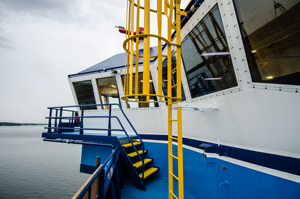 |
|
Brian Gauvin A view of the starboard bridge wing looking aft. Eastern says it based its layout for the pilothouse console on input from captains of similar vessels. Harvey Gulf puts 13 crewmembers on the boats, four more than regulations require. |
The notation recognizes vessels that exceed current regulations and meet additional standards — zero-discharge, reduced spill risk, low-sulfur fuel usage, and environmentally friendly construction materials and coatings.
“We wanted to come up with a document that incorporated all the new environmental regulations and best practices that would lead to a more environmentally friendly vessel,” said Tom Kirk, ABS’s director of environmental programs. “It’s intended to recognize vessels that go beyond current compliance and incorporate other aspects.”
Harvey Gulf sought the Enviro+ notation as part of its “Green Initiative,” Verret said. “We consider this to be the highest environmental standard in the industry, and we’re imposing this upon ourselves,” he said.
The U.S. Coast Guard’s standard for oily water separators is a discharge of no greater than 15 parts per million. The Enviro+ standard is five parts per million. The vessels have an incinerator for burning garbage and a Seahorse marine sanitation device (MSD) , a self-contained biological treatment system.
“Normally you would see an MSD unit that only treats sewage,” said Nicole Eddlemon, Harvey Gulf’s environmental compliance coordinator. “This one treats graywater as well.”
Enviro+ also takes into consideration the layout, vision and atmosphere of the operators’ work area. Proper ergonomics, comfort, sight lines and acoustic insulation contribute to safety and, therefore, to spill prevention, Eddlemon said.
“The wheelhouse is very large. That’s unique to these boats. There are hardly any obstructions for the operators of the vessel,” said Kenneth Winpigler, project manager at Eastern Shipbuilding. “We use a lot of the captains’ input in putting together the console in the early design phases.”
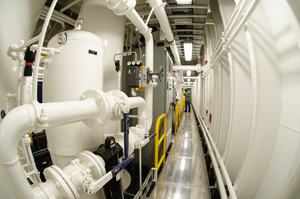 |
|
Brian Gauvin |
|
The mud tanks belowdecks. |
Along with Enviro+, the Supporter series is enrolled in the global Green Passport initiative that seeks early preparations for more environmentally friendly ship recycling at the end of a vessel’s service life. Harvey Gulf keeps track of all materials used in the construction of the OSVs, including hazardous substances, and tracks any new installations, paint and so on.
“That inventory is always kept up during the life of the ship, so if they changed equipment or repainted the hull with a different coating, that would be re-inventoried,” Eddlemon said.
Enviro+ dictates that one of the ship’s officers must be designated as environmental officer to aid compliance. Harvey Gulf did one better — adding a separate crewmember with the title Health, Safety, Security and Environmental Officer. That person has a third mate’s license.
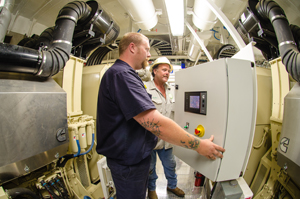 |
|
Brian Gauvin |
|
Lorin Jorgensen (left), a generator technician for Cummins Mid-South, with Chief Engineer Darrell Bickham. |
“Our company has put a whole extra person on the vessel,” Eddlemon said. “That’s not an Enviro+ requirement. That’s a company choice.”
Verret said Harvey Gulf, which is based in New Orleans, puts 13 crewmembers on the boats, four more than the regulations require: four in the pilothouse, four in the engine room, four ABs and the safety officer. Crews work 28 days on and 14 days off, and the living quarters feature soundproofing, phone banks and a theater room with a 55-inch television and rows of seating.
“Harvey Gulf started to look at the fact that our employees spend a lot of time on these vessels,” Verret said. “We have a little more bunk room and creature comforts.”
Eastern and STX officials are already working on even larger PSVs based on the Tiger Shark-class regime. A 302-footer for Harvey Gulf — currently known as Deep Sea — is scheduled for a May 2013 launch. That vessel will have a large crane, a moon pool, a stern roller and quarters for 71.
“It’s a fantastic platform, and I think we’ll see more of these,” Munroe said.

